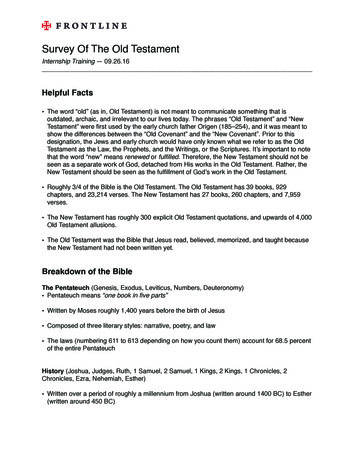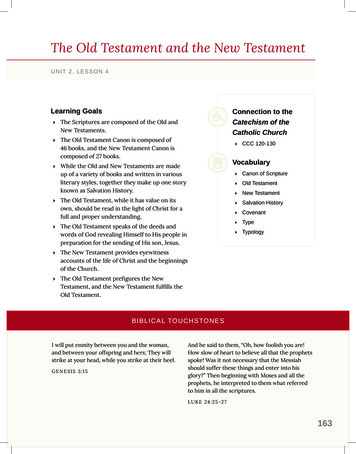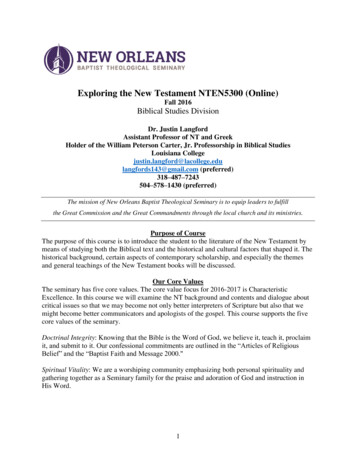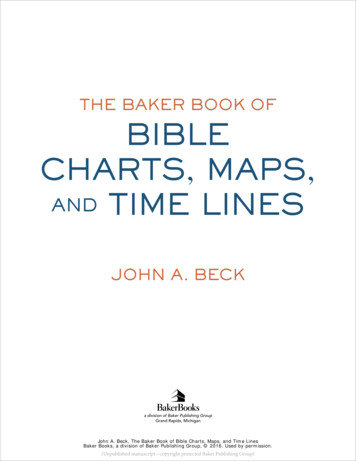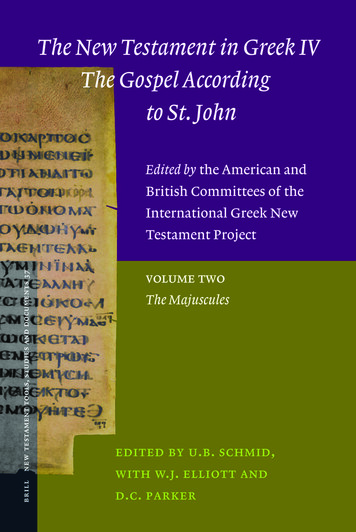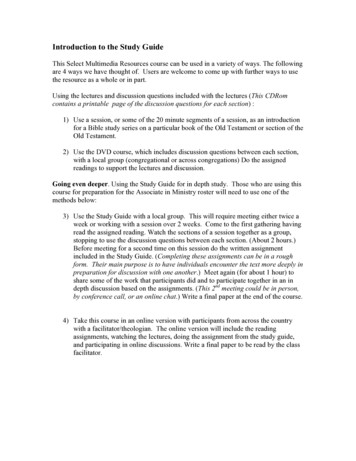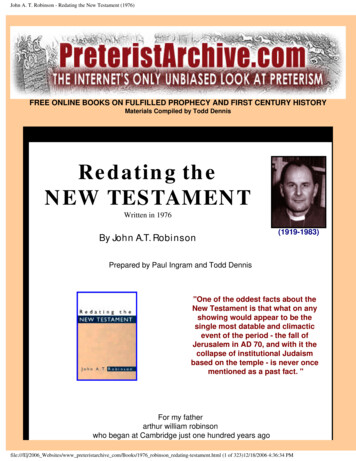
Transcription
John A. T. Robinson - Redating the New Testament (1976)FREE ONLINE BOOKS ON FULFILLED PROPHECY AND FIRST CENTURY HISTORYMaterials Compiled by Todd DennisRedating theNEW TESTAMENTWritten in 1976By John A.T. Robinson(1919-1983)Prepared by Paul Ingram and Todd Dennis"One of the oddest facts about theNew Testament is that what on anyshowing would appear to be thesingle most datable and climacticevent of the period - the fall ofJerusalem in AD 70, and with it thecollapse of institutional Judaismbased on the temple - is never oncementioned as a past fact. "For my fatherarthur william robinsonwho began at Cambridge just one hundred years agofile:///E /2006 Websites/www preteristarchive com/Books/1976 robinson redating-testament.html (1 of 323)12/18/2006 4:36:34 PM
John A. T. Robinson - Redating the New Testament (1976)to learn from Lightfoot, Westcott and Hort,whose wisdom and scholarship remain the fountof so much in this bookand my mothermary beatrice robinsonwho died as it was being finishedand shared and cared to the end.Remember that through your parents you were born;What can you give back to them that equals their gift to you?Ecclus.7.28.All Souls Day, 1975CONTENTSPrefaceAbbreviationsIDates & DataIIThe Significance of 70IIIThe Pauline EpistlesIVActs & the Synoptic GospelsVThe Epistle of JamesVIThe Petrine Epistles & JudeVIIThe Epistle to the HebrewsVIIIThe Book of RevelationIXThe Gospel & Epistles of JohnXA Post-Apostolic PostscriptXIConclusions & CorollariesEnvoifile:///E /2006 Websites/www preteristarchive com/Books/1976 robinson redating-testament.html (2 of 323)12/18/2006 4:36:34 PM
John A. T. Robinson - Redating the New Testament (1976)PREFACEI really have no more to say than thank you — to my long-suffering secretary StellaHaughton and her husband; to Professor C. F. D. Moule from whose NewTestament seminar so small a seed has produced so monstrous a manuscript, onwhich he gave such kindly judgment; to my friends, Ed Ball, Gerald Bray, ChipCoakley, Paul Hammond and David McKie, who advised or corrected at manypoints; and finally to Miss Jean Cunningham of the SCM Press for all her devotedattention to tedious detail.John RobinsonTrinity CollegeCambridgeABBREVIATIONSAFAnt.APApostolic FathersAntiquitiesApocrypha and PseudepigraphaAnnual of the Swedish TheologicalASTIInstituteATR Anglican Theological ReviewBbBiblicaBJBellum JudaicumBRBiblical ResearchBZBiblische ZeitschriftCBQ Catholic Biblical QuarterlyCHChurch HistoryChronologie der Altchrislichen LitteraturChron.(see p.4 n. 8)CNConjectanea NeotestamenticaCQR Church Quarterly ReviewDRDownside ReviewEBEncyclopedia Biblicaed(d). editors(s), edited byJTSJournal of Theological StudiesKritisch-exegetischer Kommentar über das NeueKEKNTTestamentNCBNew Century Biblen.d.no dateNEBNew English Biblen.f.neue FolgeNovTest Novum Testamentumn.s.new seriesNTNew TestamentNT Apoc. New Testament ApocryphaNTCNew Testament CommentaryNTINew Testament IntroductionNTSNew Testament StudiesOTOld Testamentpar(s). parallel(s)PCThe Primitice ChurchPCBPeake's Commentary on the Biblefile:///E /2006 Websites/www preteristarchive com/Books/1976 robinson redating-testament.html (3 of 323)12/18/2006 4:36:34 PM
John A. T. Robinson - Redating the New Testament CIDBINTJBCJBLJEAJRSJSSExpositor's Greek TestamentEvangelical QuarterlyEnglish TranslationExpository TimesThe Four GospelsHandbook of Biblical ChronologyHasting's Dictionary of the BibleHistorica EcclesiasticaHeythrop JournalHistory of the Jewish PeopleHandbuch zum Neuen TestamentHistorical Tradition in the Fourth GospelHarvard Theological ReviewHebrew Union College AnnualInterpreter's BibleInternational Critical CommentaryInterpreter's Dictionary of the BibleIntroduction to the New TestamentJerome Biblical CommentaryJournal of Biblical LiteratureJournal of Egyptian ArcheologyJournal of Roman StudiesJournal of Semitic UUSQRVCVEv.l.ZNWZTKZWTPatrologia LatinaPast and PresentRevue BibliqueRevue BénédictineReview and ExpositorRevue d'Histoire et de Philosophie ReligieusesRevue d' Histoire des ReligionsRecherches de Science ReligieuseRevised Standard VersionStudies in Biblical TheologyStudia TheologicaTimes Literary SupplementTheologische LiteraturzeitungTheologische RundschautranslatedTexte and UntersuchungenUnion Seminary Quarterly ReviewVigiliae ChristianaeVox Evangelicavaria lectioZeithchrift für die neutestamentliche WissenschaftZeithchrift für Theologie und KircheZeithchrift für wissenschaftliche TheologieIDates and DataWHEN WAS THE New Testament written? This is a question that the outsidermight be forgiven for thinking that the experts must by now have settled. Yet, as inarchaeology, datings that seem agreed in the textbooks can suddenly appear muchless secure than the consensus would suggest. For both in archaeology and in NewTestament chronology one is dealing with a combination of absolute and relativedatings. There are a limited number of more or less fixed points, and between themphenomena to be accounted for are strung along at intervals like beads on a stringaccording to the supposed require-ments of dependence, diffusion and development.New absolute dates will force reconsideration of relative dates, and the intervalswill contract or expand with the years available. In the process long-heldassumptions about the pattern of dependence, diffusion and development may beupset, and patterns that the textbooks have taken for granted become subjected tofile:///E /2006 Websites/www preteristarchive com/Books/1976 robinson redating-testament.html (4 of 323)12/18/2006 4:36:34 PM
John A. T. Robinson - Redating the New Testament (1976)radical questioning.The parallel with what of late has been happening in archaeology is interesting. Thestory can be followed in a recent book by Colin Renfrew. [C. Renfrew, BeforeCivilization: the Radiocarbon Revolution and Prehistoric Europe, 1973.] As hepresents it, there was in modern times up to about the middle of this century a moreor less agreed pattern of the origins and development of European civilization. Thetime scale was set by cross-dating finds in Crete and Greece with the establishedchronology of the Egyptian dynasties, and the evidence from Western Europe wasthen plotted by supposing a gradual diffusion of culture from this nodal point ofAegean civilization, to the remotest, and therefore the most recent, areas of Iberia,France, Britain and Scandinavia. Then in 1949 came the first radio-carbonrevolution, which made possible the absolute dating of prehistoric materials for thefirst time. The immediate effect was greatly to extend the time span. Renfrew sumsup the impact thus [Ibid., 65f.]:The succession of cultures which had previously been squeezed into500 years now occupied more than 1,500. This implies more thanthe alteration of a few dates: it changes the entire pace and nature ofthe cultural development. But . it did not greatly affect the relativechronology for the different regions of Europe: the megalithic tombsof Britain, for instance, were still later than those further south. .None of the changes . challenged in any way the conventional viewthat the significant advances in the European neolithic and bronzeage were brought by influences from the Near East. It simply putthese influences much earlier.There were indeed uncomfortable exceptions, but these could be put down to minorinconsistencies that later work would tidy up. Then in 1966 came a secondrevolution, the calibration of the radio-carbon datings by dendrochronology, or theevidence of tree-rings, in particular of the incredibly long-lived Californian bristlecone pine. This showed that the radiocarbon datings had to be corrected in anupward (i.e. older) direction, and that from about 2000 bc back-wards themagnitude of the correction rose steeply, necessitating adjustments of up to 1000years. The effect of this was not merely to shift all the dates back once more: itwas to introduce a fundamental change in the pattern of relationships, making itimpossible for the supposed diffusion to have taken place. For what should havebeen dependent turned out to be earlier.The basic links of the traditional chronology are snapped and Europeis no longer directly linked, either chronologically or culturally, withthe early civilizations of the Near East. [Ibid., 105.]The whole diffusionist framework collapses, and with it theassumptions which sustained prehistoric archaeology for nearly acentury. [Ibid., 85.]file:///E /2006 Websites/www preteristarchive com/Books/1976 robinson redating-testament.html (5 of 323)12/18/2006 4:36:34 PM
John A. T. Robinson - Redating the New Testament (1976)This is a greatly oversimplified account, which would doubtless also be challengedby other archaeologists. Nothing so dramatic has happened or is likely to happen onthe much smaller scale of New Testament chronology. But it provides an instructiveparallel for the way in which the reigning assumptions of scientific scholarship can,and from rime to time do, get challenged for the assumptions they are. For, muchmore than is generally recognized, the chronology of the New Testament rests onpresuppositions rather than facts. It is not that in this case new facts have appeared,new absolute datings which cannot be contested - they are still extraordinarilyscarce. It is that certain obstinate questionings have led me to ask just what basisthere really is for certain assumptions which the prevailing consensus of criticalorthodoxy would seem to make it hazardous or even impertinent to question. Yetone takes heart as one watches, in one's own field or in any other, the way in whichestablished positions can suddenly, or subtly, come to be seen as the precariousconstructions they are. What seemed to be firm datings based on scientific evidenceare revealed to rest on deductions from deductions. The pattern is self-consistent butcircular. Question some of the inbuilt assumptions and the entire edifice looks muchless secure.The way in which this can happen, and has happened, in New Testamentscholarship may best be seen by taking some sample dips into the story of thesubject. I have no intention of inflicting on the reader a history of the chronology ofthe New Testament, even if I were competent to do so. Let me just cut some crosssections at fifty-year intervals to show how the span of time over which the NewTestament is thought to have been written has expanded and contracted with fashion.We may start at the year 1800. For till then, with isolated exceptions, the historicalstudy of the New Testament as we know it had scarcely begun. Dating wasdependent on authorship, and the authorship of the various New Testament booksrested on the traditions incorporated in their titles in the Authorized Version - theGospel according to St Matthew, the Epistle of Paul the Apostle to the Ephesians,the Revelation of St John the Divine, and so on. All were by apostles or followers ofthe apostles and the period of the New Testament closed with the death of the lastapostle, St John, who by tradition survived into the reign of the Emperor Trajan, c.100 ad. At the other end the earliest Christian writing could be calculated roughlyto about the year 50. This was done by combining the history of the early churchprovided in Acts with the information supplied by St Paul in Gal. 1.13-2.1 of aninterval of up to seventeen 'silent' years following his conversion, which itself hadto be set a few years after the crucifixion of Jesus in c. 30. The span of time for thecomposition of the New Testament was therefore about fifty years - from 50 to 100.By 1850 the picture looked very different. The scene was dominated by the schoolof F. C. Baur, Professor of Church History and Dogmatics at Tübingen from 1826to 1860. He questioned the traditional attribution of all but five of the NewTestament books. Romans, I and II Corinthians and Galatians he allowed were byPaul, and Revelation by the apostle John. These he set in the 50s and late 60sfile:///E /2006 Websites/www preteristarchive com/Books/1976 robinson redating-testament.html (6 of 323)12/18/2006 4:36:34 PM
John A. T. Robinson - Redating the New Testament (1976)respectively. The rest, including Acts and Mark (for him the last of the synoptists,'reconciling' the Jewish gospel of Matthew and the Gentile gospel of Luke), werecomposed up to or beyond 150 ad, to effect the mediation of what Baur saw as thefundamental and all-pervasive conflict between the narrow Jewish Christianity ofJesus' original disciples, represented by Peter and John, and the universalisticmessage preached by Paul. Only a closing of the church's ranks in face of threatsfrom the Gnostic and Montanist movements of the second century produced the viamedia of early Catholicism. The entire construction was dominated by the Hegelianpattern of thesis, anti-thesis and synthesis, and the span of time was determinedmore by the intervals supposedly required for this to work itself out than by anyobjective chronological criteria. The fact that the gospels and other New Testamentbooks were quoted by Irenaeus and other church fathers towards the end of thesecond century alone set an upper limit. The end-term of the process was still thegospel of John, which was dated c. 160-70. The span of composition was thereforemore than doubled to well over a hundred years - from 50 to 160 .By 1900 this schema had in turn been fairly drastically modified. The dialecticalpattern of development had come to be recognized as the imposition it was [For thestory, cf. W. G. Kummel, The New Testament: The History of the Investigation ofits Problems, ET 1973, 162-84.]. A major factor in the correction of Baur's pictureof history was the work of J.B. Lightfoot, who was appointed a professor atCambridge in 1861, the year following Baur's death [Lightfoot's achievement isparticularly well brought out by S. C. Neill, The Interpretation of the NewTestament, 1861-1961, Oxford 1964, 33-60.]. By the most careful historicalinvestigation he succeeded in establish-ing the authenticity of the first epistle ofClement, which he dated at 95-6, and of the seven genuine epistles of lgnatius,between no and 115. In each of these both Peter and Paul are celebrated in the samebreath without a trace of rivalry [I Clem. 5; Ignatius, Rom. 4.3.], and hedemonstrated how ground-less were Baur's second-century datings. Thisachievement was acknowledged by the great German scholar Adolf von Harnack(1851-1930), who in 1897 published as the second volume of a massive history ofearly Christian literature [A. Harnack, Geschichte der altchristlichen Litteratur bisEusehius, Leipzig 1893-7, vol. II (cited hereafter as Chron.).] his Chronologic deraltchristlichen Litteratur bis Eusebius. Harnack's survey, which has never beenrepeated on so comprehensive a scale [For a survey of surveys, cf. 0. Stahlin in W.Schmid and 0. Stahlin (cdd.), Geschichte der griechische Literatur, Munich 1961,11.2, esp. 1112—1121.], gives a good indication of where critical opinion stood atthe turn of the century. It still carried many of the marks of the Tiibingen period andcontinued to operate with a span of well over a hundred years. Isolating thecanonical books of the New Testament (for Harnack covered all the early Christianwritings, a number of which he placed before the later parts of the New Testament),we have the following summary [Chron.717-22. A comparable picture is to befound a few years earlier in A. Julicher's Einleitung in das neue Testament,Tubingen 1894, though he put Mark after 70 and the Pastoral Epistles (I and IITimothy and Titus) at I25 .] (ignoring qualifications and alternative datings at thispoint as irrelevant to the broad picture):file:///E /2006 Websites/www preteristarchive com/Books/1976 robinson redating-testament.html (7 of 323)12/18/2006 4:36:34 PM
John A. T. Robinson - Redating the New Testament 90-11093-6100-30120-40160-75I and II ThessaloniansI and II Corinthians, Galatians (?)RomansColossians, Philemon, Ephesians (if genuine),PhilippiansPauline fragments of the Pastoral EpistlesMarkMatthewLuke-Acts('under Domitian') I Peter, HebrewsJohn, I-111 JohnI and II Timothy, TitusRevelationJudeJamesII PeterIt is to be observed that the gospel of John has reverted to somewhere around theturn of the first century and no longer represents the terminus ad quern. Mark andActs have been set much further back, and Harnack was subsequently to put them agood deal earlier still.A similar but slightly more contracted scheme is to be found in the article on NewTestament chronology by H. von Soden in the con-temporary EncyclopaediaBiblica [Encyclopaedia Biblica, edd. T. K. Cheyne and J. S. Black, 1899-1903, I,799-819.] His summary dates are:50-60 70 93-96-100100-33The Pauline EpistlesMarkHebrews, I Peter, RevelationEphesians, Luke, Acts, John, I-III JohnJude, Matthew, the Pastoral EpistlesThe individual articles in the same Encyclopaedia reveal however how volatileopinion was at that time. Acts is still put well into the second century and Johnshortly before 140. No date for II Peter is given, but even I Peter is put at 130-40.Above all, while I and II Corinthians are set in the mid-50s, Romans and Philippiansare put in 120 and 125! But the articles on the latter two were written by the Dutchscholar W. C. van Manen (1842-1905), who regarded all the Pauline epistles (andindeed the rest of the New Testament literature) as pseudonymous, or written underfalse names.file:///E /2006 Websites/www preteristarchive com/Books/1976 robinson redating-testament.html (8 of 323)12/18/2006 4:36:34 PM
John A. T. Robinson - Redating the New Testament (1976)Yet while the radical critics were still oscillating wildly, conservative, yet stillcritical, opinion of the period was content to settle for a span of compositionbetween 50 and 100 , with the single exception of II Peter at c. 150. This was trueboth of English scholarship reflected in Hastings' Dictionary of the Bible[Dictionary of the Bible, ed. J. Hastings, Edinburgh 1898-1904.] and of Americanrepresented by B. W. Bacon's Introduction to the New Testament [B. W. Bacon,Introduction to the New Testament, New York 1900.]. Indeed the most conservativedating of all was by the German Theodore Zahn (1838-1933) whose Introduction tothe New Testament [T. Zahn, Introduction to the New Testament, originally Leipzig1897-9, ET Edinburgh 1909.] a monument of erudition and careful scholarship, setall the books between 50 and 95, including II Peter.By 1950 the gap between radical and conservative had narrowed considerably, andwe find a remarkable degree of consensus. There is still marginal variation at theupper limit, but the span of composition has settled down to a period from about 50to 100 or no, with the single exception again of II Peter (c. 150). This generalizationholds of all the major introductions and comparable surveys, English, American andContinental, Protestant and Catholic, published over the twenty years following1950. [R. G. Heard, An Introduction to the New Testament, 1950; H. F. D. Sparks,The Formation of the New Testament, 1952; A. H. McNeile, An Introduction to theStudy of the New Testament, revised by C. S. C. Williams, Oxford 1953 (citedhenceforth as McNeile-Williams); W. Michaelis, Einleitung in das neue Testament,Bern 1954; A. Wikenhauser, New Testament Introduction (Freiburg 21956), ETNew York 1958; A. Robert and A. Feuillet, Introduction to the New Testament(Tournai 1959), ET New York 1965; D. Guthrie, New Testament Introduction, 19615, 31970; Peake's Commentary on the Bible, revised, ed. M. Black, 1962; TheInterpreter's Dictionary of the Bible, New York 1962; R. M. Grant, A HistoricalIntroduction to the New Testament, i963;W. G. Kummel, Introduction to the NewTestament (Heidelberg i963),ET 1966; 21975; W. Marxsen, Introduction to the NewTestament (Gutersloh 1963), ET Oxford 1968; E. F. Harrison, Introduction to theNew Testament, 1964; R. H. Fuller, A Critical Introduction to the New Testament,1966; W. D. Davies, Invitation to the New Testament, New York 1966; A. F. J.Klijn, An Introduction to the New Testament, ET Leiden 1967; D.J. Selby,Introduction to the New Testament, New York 1971.]The prevailing position is fairly represented by Kummel, who tends to be moreradical than many Englishmen and more conservative than many Germans. Hisdatings, again omitting alternatives, are:50-153-656-8c.70I and II ThessaloniansGalatians, Philippians, I and II Corinthians,RomansColossians, PhilemonMarkfile:///E /2006 Websites/www preteristarchive com/Books/1976 robinson redating-testament.html (9 of 323)12/18/2006 4:36:34 PM
John A. T. Robinson - Redating the New Testament (1976)70-9080-9080-10090-590-10090-110-100c.100100 125-50LukeActs, HebrewsMatthew, EphesiansI Peter, RevelationJohnI-III JohnJamesJudeI and II Timothy, TitusII PeterIn this relatively fixed firmament the only 'wandering stars' are Ephesians, I Peter,Hebrews and James (and occasionally the Pastor-als and Jude), which conservativeswish to put earlier, and Colossians and II Thessalonians, which radicals wish to putlater. So once more the span (with one exception) is back to little more than fiftyyears.But before closing this survey I would draw attention to the latest assessment of all,Norman Perrin's The New Testament: An Introduction [N. Perrin, The NewTestament: An Introduction, New York 1974.], since it could suggest a return to awider spread. His approximate datings are:I Thessalonians, Galatians, I and II50-60 Corinthians, Philippians, Philemon,RomansII Thessalonians, Colossians,70-90 Ephesians, Mark, Matthew, Luke-Acts,Hebrews80-100 John, I-III John90-100 RevelationI Peter, James, Pastoral Epistles,Jude, II Peter [The order of this last90-140 group is only a guess. No dates are given,except that I Peter is about the end of thefirst century and II Peter c. 140.]Perrin represents the standpoint of redaction criticism, which goes on from sourcecriticism (dealing with documentary origins) and form criticism (analysing theformative processes of the oral tradition) to emphasize the theological contributionof the evangelists as editors. There is no necessary reason why its perspectiveshould lead to later datings. Indeed other representatives of the same viewpoint whohave written New Testament introductions, Marxsen and Fuller, have taken overtheir precursors' datings. Moreover, the gospels, with which the redaction criticsfile:///E /2006 Websites/www preteristarchive com/Books/1976 robinson redating-testament.html (10 of 323)12/18/2006 4:36:34 PM
John A. T. Robinson - Redating the New Testament (1976)have been most concerned, all remain, including the fourth, within what Perrin calls'the middle period of New Testament Christianity', 'the twenty-five years or so thatfollowed the fall of Jerusalem'. Yet subsequent to this period he sees a further stage,extending into the middle of the second century, in which the New Testamentchurch is 'on the way to becoming an institution'. If we ask why it is only thenbecoming an institution, the answer is bound up with his 'theological history of NewTestament Christianity' [Op. cit, 39-63.]. The course of this he traces from'Palestinian Jewish Christianity', through 'Hellenistic Jewish Mission Christianity','Gentile Christianity' and 'the apostle Paul', to 'the middle period', and finally into'emergent Catholicism'. Yet these categories, taken over from Rudolf Bultmann andhis successors, have of late come in for some stringent criticism not only fromEngland [I. H. Marshall, 'Palestinian and Hellenistic Christianity: Some CriticalComments', NTS 19, 1972-3, 271-87; 'Early Catholicism' in R. N. Longenecker andM. C. Tenney (edd.), New Dimensions in New Testament Study, Grand Rapids,Michigan, 1974, a 17-31.] but from Ger-many itself [M. Hengel, 'Christologie andneutestamentliche Chronologic' in H. Baltens-weiler and B. Reicke (edd.), NeuesTestament und Geschichte: Oscar Cullmann zum 70. [Geburtstag, Zurich andTubingen 1972, 43-67; Judaism and Hellenism, ET 1974.], none of which Perrinacknowledges. The entire developmental schema (closely parallel to the 'diffusionistframework' in archaeology), together with the time it is assumed to require, beginsto look as if it may be imposed upon the material as arbitrarily as the earlier one ofthe Tiibingen school. It is premature to judge. But certainly it cannot itself be usedto determine the datings which are inferred from it. It must first be submitted to amore rigorous scrutiny in the light of the independent data.Indeed what one looks for in vain in much recent scholarship is any seriouswrestling with the external or internal evidence for the daring of individual books(such as marked the writings of men like Lightfoot and Harnack and Zahn), ratherthan an a priori pattern of theological development into which they are then made tofit. [Perrin's particular schema is in itself fairly arbitrary. It is hard to see by whatcriteria of doctrine or discipline I and II Peter are both subsumed under the head-ingof 'emergent Catholicism'; in fact in the analysis of the marks of this phe-nomenon(op. cit., 268-73) I Peter is scarcely mentioned. Moreover, while he acknowledgeshis deep indebtedness to E. Kasemann for his estimate of II Peter ('An Apologia forPrimitive Christian Eschatology', Essays on New Testament Themes, ET (SBT 41)1964, 169-95), he ignores Kasemann's equally strong con-tention ('Ketzer undZeuge', ZTK 48, 1951, 292-311) that III John reflects a second-century transition toIgnatian monepiscopacy. (Of the Johannine epistles he merely says, 249: 'We arenow in the middle period of New Testament Chris-tianity.') He does not explainwhy I Clement's concern for apostolic succession and Ignatius' plea for unity aroundthe monarchical bishop (quintessential interests, one would have thought, of'emergent Catholicism') receive no mention in New Testament documentssupposedly later than they are.] In fact ever since the form critics assumed the basicsolutions of the source critics (particularly with regard to the synoptic problem) andthe redaction critics assumed the work of the form critics, the chronology of theNew Testament documents has scarcely been subjected to fresh examination.No one since Harnack has really gone back to look at it for its own sake or tofile:///E /2006 Websites/www preteristarchive com/Books/1976 robinson redating-testament.html (11 of 323)12/18/2006 4:36:34 PM
John A. T. Robinson - Redating the New Testament (1976)examine the presuppositions on which the current consensus rests. It is only whenone pauses to do this that one realizes how thin is the foundation for some of thetextbook answers and how circular the arguments for many of the relative datings.Disturb the position of one major piece and the pattern starts disconcertingly todissolve.That major piece was for me the gospel of John. I have long been convinced thatJohn contains primitive and reliable historical tradition, and that conviction has beenreinforced by numerous studies in recent years. But in reinforcing it these samestudies have the more insistently provoked the question in my mind whether thetraditional dating of the gospel, alike by conservatives and (now) by radicals,towards the end of the first century, is either credible or necessary. Need it havebeen written anything like so late? As the arguments requiring it to be set at aconsiderable distance both in place and time from the events it records began one byone to be knocked away (by growing recognition of its independence of thesynoptists and, since 1947 by linguistic parallels from the Dead Sea Scrolls), I havewondered more and more whether it does not belong much nearer to the Palestinianscene prior to the Jewish revolt of 66-70.But one cannot redate John without raising the whole question of its place in thedevelopment of New Testament Christianity. If this is early, what about the othergospels? Is it necessarily the last in time? Indeed does it actually become the first?- or are they earlier too? And, if so, how then do the gospels stand in relation to theepistles? Were all the Pauline letters penned, as has been supposed, before any ofthe gospels? Moreover, if John no longer belongs to the end of the century, what ofthe Johannine epistles and the other so-called Catholic Epistles which have tendedto be dated with them? And what about the book of Revelation, which, whatever itsconnection with the other Johannine writings, everyone seems nowadays to set inthe same decade as the gospel?It was at this point that I began to ask myself just why any of the books of the NewTestament needed to be put after the fall of Jerusalem in 70. As one began to lookat them, and in particular the epistle to the Hebrews, Acts and the Apocalypse, wasit not strange that this cataclysmic event was never once mentioned or apparentlyhinted at? And what about those predictions of it in the gospels - were they reallythe prophecies after the event that our critical education had taught us to believe?So, as little more than a theological joke, I thought I would see how far one couldget with the hypothesis that the whole of the New Testament was written before70. And the only way to try out such a hypothesis was to push it to its limits, andbeyond, to discover what these limits were. Naturally, there were bound to beexceptions - II Peter was an obvious starter, and presumably the Pastorals - but itwould be an interesting exercise.But what began as a joke became in the process a serious pre-occupation, and Iconvinced myself that the hypothesis must be tested in greater detail than theseminar-paper with which it started would allow. The result is that I have foundfile:///E /2006 Websites/www preteristarchive com/Books/1976 robinson redating-testament.html (12 of 323)12/18/2006 4:36:34 PM page
Dating was dependent on authorship, and the authorship of the various New Testament books rested on the traditions incorporated in their titles in the Authorized Version - the Gospel according to St M


